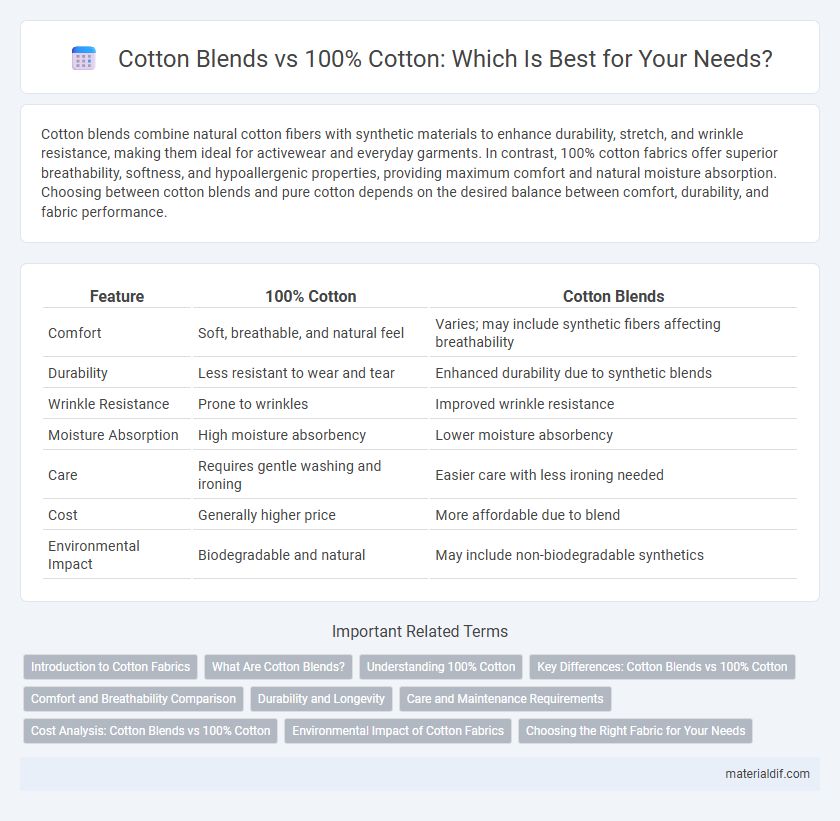Cotton blends combine natural cotton fibers with synthetic materials to enhance durability, stretch, and wrinkle resistance, making them ideal for activewear and everyday garments. In contrast, 100% cotton fabrics offer superior breathability, softness, and hypoallergenic properties, providing maximum comfort and natural moisture absorption. Choosing between cotton blends and pure cotton depends on the desired balance between comfort, durability, and fabric performance.
Table of Comparison
| Feature | 100% Cotton | Cotton Blends |
|---|---|---|
| Comfort | Soft, breathable, and natural feel | Varies; may include synthetic fibers affecting breathability |
| Durability | Less resistant to wear and tear | Enhanced durability due to synthetic blends |
| Wrinkle Resistance | Prone to wrinkles | Improved wrinkle resistance |
| Moisture Absorption | High moisture absorbency | Lower moisture absorbency |
| Care | Requires gentle washing and ironing | Easier care with less ironing needed |
| Cost | Generally higher price | More affordable due to blend |
| Environmental Impact | Biodegradable and natural | May include non-biodegradable synthetics |
Introduction to Cotton Fabrics
Cotton blends combine natural cotton fibers with synthetic materials like polyester to enhance durability, wrinkle resistance, and moisture-wicking properties, making them ideal for activewear and easy-care garments. In contrast, 100% cotton fabrics offer superior breathability, softness, and hypoallergenic benefits, ensuring comfort and natural moisture absorption. Understanding the differences in fiber composition helps consumers choose fabrics that balance comfort, performance, and care requirements.
What Are Cotton Blends?
Cotton blends combine natural cotton fibers with synthetic materials like polyester to enhance durability, wrinkle resistance, and moisture-wicking properties. These blends often offer a balanced fabric that maintains the breathability and softness of cotton while improving strength and longevity compared to 100% cotton. By adjusting the ratio of blends, manufacturers tailor textiles for specific uses, such as activewear, casual clothing, or home textiles.
Understanding 100% Cotton
100% cotton fabric offers exceptional breathability, natural softness, and hypoallergenic properties, making it ideal for sensitive skin and everyday wear. Unlike cotton blends, which mix cotton with synthetic fibers for durability and wrinkle resistance, 100% cotton ensures maximum comfort and moisture absorption. Understanding 100% cotton helps consumers prioritize natural fiber benefits such as biodegradability and superior temperature regulation in their clothing and home textiles.
Key Differences: Cotton Blends vs 100% Cotton
Cotton blends combine natural cotton fibers with synthetic materials like polyester, resulting in fabric that offers enhanced durability, wrinkle resistance, and moisture-wicking properties compared to 100% cotton. In contrast, 100% cotton provides superior breathability, softness, and natural hypoallergenic qualities but tends to shrink and wrinkle more easily after washing. The choice between cotton blends and 100% cotton depends on the desired balance between comfort, maintenance, and fabric performance.
Comfort and Breathability Comparison
Cotton blends often enhance durability and wrinkle resistance but may reduce the natural breathability and softness found in 100% cotton fabrics. Pure cotton offers superior moisture absorption and airflow, making it ideal for comfort in warm climates or sensitive skin. Choosing between cotton blends and 100% cotton depends on the balance desired between longevity and breathable comfort.
Durability and Longevity
Cotton blends combine natural cotton fibers with synthetic materials like polyester to enhance durability and resistance to wear, making garments less prone to shrinking and wrinkling compared to 100% cotton. While 100% cotton offers superior breathability and softness, it tends to wear out faster and may lose shape after repeated washing. Choosing cotton blends ensures longer-lasting textiles that maintain their form and color over time, ideal for everyday use and heavy-duty wear.
Care and Maintenance Requirements
Cotton blends often require less maintenance than 100% cotton due to the presence of synthetic fibers that enhance wrinkle resistance and reduce shrinkage. While 100% cotton fabrics are breathable and soft, they typically need gentle washing, lower heat drying, and occasional ironing to maintain their appearance and longevity. Proper care of both materials involves following specific washing instructions to prevent color fading and fabric wear, but blends generally offer more durability and easier upkeep.
Cost Analysis: Cotton Blends vs 100% Cotton
Cotton blends typically offer a more cost-effective option compared to 100% cotton due to the inclusion of synthetic fibers like polyester, which lowers production expenses and retail prices. While 100% cotton fabrics often command higher prices because of natural fiber content and superior breathability, blends balance affordability with durability and wrinkle resistance. Evaluating total cost of ownership, including longevity and maintenance, reveals that cotton blends may provide greater value for budget-conscious consumers.
Environmental Impact of Cotton Fabrics
Cotton blends often incorporate synthetic fibers like polyester, which contribute to microplastic pollution and are less biodegradable compared to 100% cotton fabrics. While 100% cotton requires significant water and pesticide use, it remains a natural, biodegradable fiber with lower long-term environmental impact than blends. Sustainable farming practices and organic cotton farming can further reduce the ecological footprint of 100% cotton textiles.
Choosing the Right Fabric for Your Needs
Cotton blends combine natural cotton fibers with synthetic materials like polyester, enhancing durability, wrinkle resistance, and moisture-wicking properties, making them ideal for activewear and easy-care garments. 100% cotton, prized for its breathability, softness, and hypoallergenic qualities, is preferred for sensitive skin and classic, comfortable apparel. Selecting the right fabric depends on lifestyle needs, with blends suited for longevity and performance, while pure cotton ensures natural comfort and breathability.
Cotton Blends vs 100% Cotton Infographic

 materialdif.com
materialdif.com